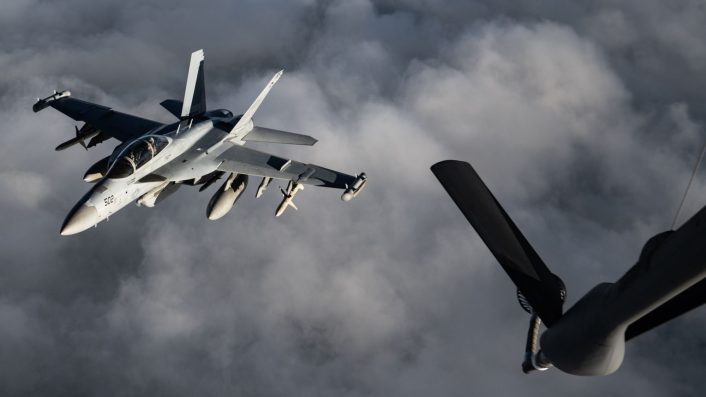The Growler was seen launching from the USS Truman aircraft carrier with a heavy payload of four AGM-88E AARGM missiles and without the ALQ-99 TJS.
In a rare configuration, reflecting the complexity of the threat posed by the Houthis, an E/A-18G Growler, assigned to the Electronic Attack Squadron (VAQ-144) “Main Battery” on the USS Harry S. Truman aircraft carrier, has been spotted with four AGM-88E AARGMs (Advanced Anti-Radiation Guided Missile), or older AGM-88C HARMs (High-Speed Anti-Radiation Missile). The heavy payload of the aircraft was the focus of a video released by the U.S. Central Command (CENTCOM) on Apr. 21, 2025.
Usually the Growler only carries two radar-killing missiles, together with external fuel tanks and jamming pods. On this occasion, the EA-18G was carrying four AGM-88s under its wings, together with three 480-gallon external fuel tanks (on the inner wing hardpoints and on the centerline) and two AIM-120 AMRAAMs (Advanced Medium-Range Air-to-Air Missile) on the ‘cheek’ station outside the air intakes.
Usually, while carrying two HARMs, the Growlers also carry three AN/ALQ-99 TJS (Tactical Jamming System) pods. These are set to be replaced by the Next-Generation Jammer pods, which include the AN/ALQ-249 NGJ-MB (Next-Generation Jammer-Mid Band) and the NGJ-LB (Next-Generation Jammer-Low Band).
The NGJ-MB pods were tactically employed for the first time by Growlers of the VAQ-133 “Wizards” aboard the USS Abraham Lincoln from Jul. 2024 to Dec. 2024. On that occasion, the carrier deployed to both the Indo-Pacific and the Middle East in the CENTCOM (Central Command) AOR (Area of Responsibility).
In the video on the left we see an EA-18G Growler, assigned to Electronic Attack Squadron (VAQ) 144 “Main Battery”, equipped with four Advanced Anti-Radiation Guided Missiles (AARGMs), two Advanced Medium-Range Air-to-Air Missiles (AMRAAMs) & three 480-gallon external fuel tanks. https://t.co/4LNi0yDCtU pic.twitter.com/Q7sXqq8SDa
— Guy Plopsky (@GuyPlopsky) April 21, 2025
Need in Yemen
Strikes against the Yemen-based and Iran-backed group continue, more than a month after U.S. forces launched a large-scale operation against Houthi targets in Yemen to stop any threat to international shipping posed by the rebel group. The U.S. Navy has been on the frontline, with its Super Hornet and Growlers flying every day to strike Houthi targets.
The carrier-based F/A-18E/F Super Hornets have been spotted with air-to-ground stores like the AGM-154 JSOW (Joint Standoff Weapon), the AGM-84H SLAM-ER (Standoff Land Attack Missile-Expanded Response) and, more recently, the GBU-53/B Stormbreaker SDB II. A loadout of four AGM-88 as seen on the EA-18G is rare, bearing that the U.S. Navy is not taking any chances after six MQ-9s have been shot down in the area since March 2025.
A missile that has often emerged in both the Iranian and Houthis’ arsenal is the ‘358’ missile, which Press TV calls a “dual use” system, being able to “function both as a loitering missile and an Unmanned Aerial Vehicle.” While the missile has been spotted since 2019, it emerged in official Iranian and Russian publicity material only in Sep. 2023, during the latter’s former defense minister Sergei Shoigu’s visit to Iran, attending a defense exhibition organized by the IRGC (Islamic Revolutionary Guard Corps).
It is possible this weapon have been widely used against the MQ-9s, given how the remote operation makes it more suitable against the slow-moving drones with a control latency. Feb. 2025 also saw the Houthis unsuccessfully launching a SAM against a U.S. fighter, according to Reuters, with some reports claiming it to be an F-16.
Quoting a study by Israel’s Alma Research Center, Defence Industry Europe said that the 358 missile (also known as SA-67) has an advanced electro-optical seeker, “effective against helicopters, light aircraft, and medium-altitude UAVs.” The nature of the man-in-the-loop element and whether the missile is semi-autonomous or fully autonomous at any stage is unclear, but the absence of ground-based surveillance and tracking radars somewhat complicates typical SEAD/DEAD strikes.

AGM-88E AARGM
A scenario like Yemen is where the capabilities of the AARGM might come into play. Unlike the AGM-88 HARM, the AGM-88E has an active millimeter-wave radar seeker, which allows it to strike targeting radars even after they stop emitting. Adversary ground radar crews often intermittently turn on their radars just to be able to quickly check for aerial threats without exposing their position.
This is done as a compromise between being detected by SEAD assets while also not lending completely uncontested skies to opposing aircraft. Russian Tor and Buk-M2 short- and medium-range air defense crews often adopted the practice when the U.S. introduced ADM-160 MALDs. They were significantly successful in causing the AGM-88 HARMs to veer off course when their radars turned off.
🇺🇸 Nice shot showing a U.S. Navy EA-18G Growler flying over the U.S. Central Command area of responsibility, March 29, 2025.
(📸/U.S. Air Force photo by Staff Sgt. Gerald R. Willis) pic.twitter.com/JZGBjanWiy
— Guy Plopsky (@GuyPlopsky) April 22, 2025
The AARGM is capable not only of following the radiations back to the source, but also of switching to GPS/INS navigation if the emitter goes “cold” and heading in that direction with the MMW radar helping to track the ‘missing link’, even when the target is mobile. The wingtip mounted AN/ALQ-218 receivers, capable of ESM (Electronic Support Measures) and ELINT (Electronic Intelligence), help in identifying and locating such elusive radar emitters.
🇺🇲 An AGM-88E Advanced Anti-Radiation Guided Missile (AARGM) is seen here under the port wing of an EA-18G Growler, assigned to Electronic Attack Squadron (VAQ) 144 “Main Battery”, on the flight deck of the USS Harry S. Truman (CVN 75), March 16, 2025.
(📸/Seaman Joshua Dennis) pic.twitter.com/47jGOa9Qx8
— Guy Plopsky (@GuyPlopsky) March 18, 2025
According to NAVAIR, the AARGM uses new guidance and control sections mated with the older AGM-88 HARM’s warhead, rocket motor, wings and fins. The baseline capabilities include an “expanded target set, counter-shutdown capability,” and “advanced signals processing.” According to The War Zone, the AARGM therefore “has a secondary role as a rapid-response strike weapon against non-air defense-related targets.”
In May 2024, the U.S. AFCENT (United States Air Forces Central) released a routine image of a Growler crew from the VAQ-130 “Zappers” aboard the USS Dwight D. Eisenhower, where the aircraft bore the kill mark of a Mi-24 Hind attack helicopter on the fuselage. The U.S. Navy subsequently confirmed to TWZ that an EA-18G Growler of the “Zappers” used the AARGM against the Mi-24/35 Hind attack helicopter.










